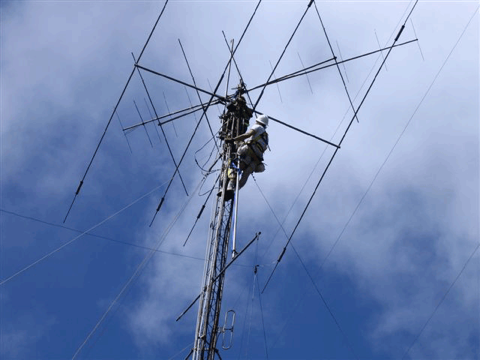Overview
(or what we do, how and why)
This is a system composed of chained radio links. Radio repeaters, (Remote Base), receive inputs from users, usually operating mobile. When the repeater picks up a properly encoded radio signal, it turns on its associated transmitter and repeats what it hears on a nearby frequency. A controller supervises this activity. Each Intertie, Incorporated member is a trained control operator, and is thus privileged to control all 21 Remote Base locations in the system. The controller hardware and software is programmed to accept a large array of operational and configuration commands. Some of these allow the repeater to be connected ("interfaced") to a co-located transmitter/receiver combination, which operates on a different channel pair. This radio linking configuration transmits messages to the next site in the chain. The next site is operationally similar. If commanded to do so, the link signal is retransmitted by the distant repeater transmitter. An operator at the distant site can pick up his talkie, send the necessary interface command(s) and visit the other repeater via the link. The Intertie system can do this through 23 different locations across south and west Texas. Controlled access allows interface with the Armadillo Intertie, serving north, east and west Texas, as well as the Cactus Intertie System even further west.
Boy, that's a big operation - Who pays for it?
In a word, we pay our own way. As a (501)(c)(3) “not for profit” educational, scientific charitable organization, we are exempt from federal and state taxes. We do accept donations of radio transmitting and receiving equipment or cash. But we operate on a relatively meager budget supported by member dues and pledges. We build a majority of our operating equipment through members who donate their time for construction and System maintenance.
What do you give back to the community?
We stand ready to provide emergency communications wherever needed within our operating area (which is pretty huge). We are regular participants in local and regional disaster planning, drills and operations. Most of our sites have backup emergency power to facilitate communications on demand regardless of outside support.
We have published the results of our research in national scientific media. While conducting ongoing research we also train amateurs in more advanced communications theory and operation. This has proved to be quite entertaining (visits to some awesome scenery on private and public real estate), as well as a learning experience for all, gray hairs included. Members include fledgling radio operators in our ongoing research and development effort by teaching more basic classes.
Members also serve on regional and national committees dealing with radio frequency matters, hold offices in various emergency organizations such as ARES and RACES and serve as officers in the Texas VHF FM Society, (http://www.txvhffm.org).

No use of these symbols or phrases is allowed without the express written permission of Intertie, Inc.
